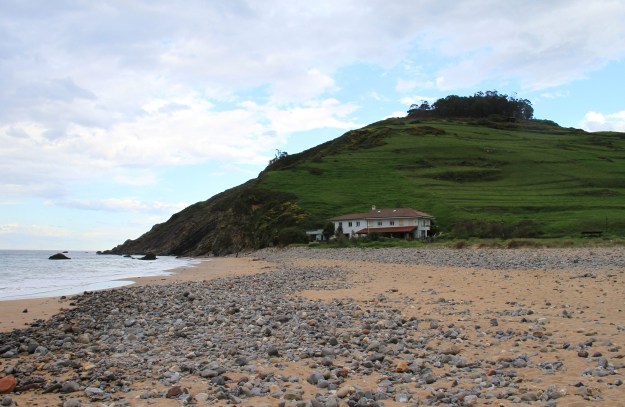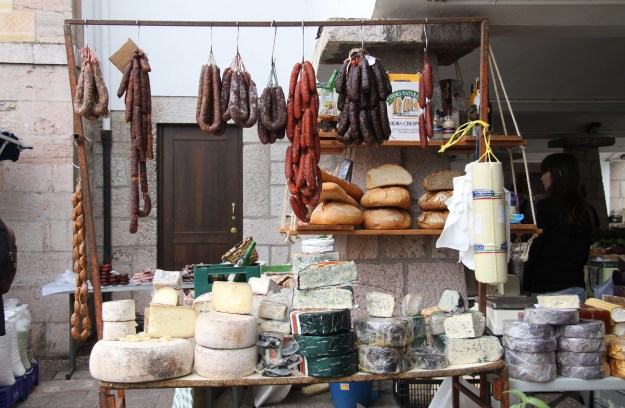1. Asturias es España; lo demás es tierra conquistada. “Asturias is Spain; the rest is conquered territory.” It’s a saying you hear a lot around Asturias, the region in the northwest of Spain where I was born. It’s a reminder that Asturians have always been resistant to anyone who threatens their home or their way of life. After the Moors conquered most of Spain during their 800-year reign, Asturias became the cradle of the Reconquista, the place where Christians began their campaign to reclaim the country.
2. This is not the Spain of your imagination. It looks and feels very different from any other corner of the country. Before its dramatic peaks, rugged coastline, and shamrock-green valleys, you could as easily be in Ireland as the Iberian Peninsula. Naturally, the culture is quite different from elsewhere. Looking for colorful flamenco dancers? Pitchers of sangría? Bullfights? Sevilla is 500 miles due south. Vaya con dios! You come to Asturias because it’s gorgeous and delicious and totally different from any other part of Spain.
3. Expect the unexpected. Everything is so predictable when you travel today. Before I go to a restaurant, I already know what the meal is going to be. I already know the paintings in the museums, the curves and angles in the monuments. The sense of discovery is gone. It feels like a book whose ending I already read. In Asturias, you never know the end of the story. You’ll get lost. You’ll meet all sorts of interesting characters. Plans will change with the weather, with your appetite, with the new friends you make along the way. My best advice: Just go with it.


4. Asturians are like hobbits. I mean that in the best possible way. They live simple, honest lives: both isolated and ready to defend their home to the end, but also shamelessly welcoming to visitors. If you come in peace, they’ll show you how to pour cider, pass you a toothpick of chorizo or octopus, and teach you the songs they love to sing—the Asturian national anthem above all, which they’ll sing anytime you give them an excuse. Asturias, Patria Querida …
5. Pack your umbrella. Think all that rolling green landscape got there by itself? Don’t be silly. It rains here. A lot. It’s not like rain in the rest of the world. It’s so wet in Asturias that they give names to their rain. L’orbayu is a rain that isn’t rain—a mist so fine you don’t even know you’re being rained on. Pockets of fog and clouds will come out of nowhere and swallow you whole. You won’t be able to see more than a few feet in front of your car. Don’t despair. Just as quickly as it comes, it disappears, leaving a million rainbows in its wake.
6. Go high, go low. Asturias is a land of crazy physical contrasts. You can eat wild boar stew for lunch on top of the Picos de Europa, some of the highest mountains in Spain, and be stretched out on a perfect slice of Atlantic sand in time for siesta. I call these food-driven mountain-to-sea expeditions my “surf-and-turf combos,” and I have a handful of favorites: Begin in Cangas de Onís with refined mountain fare at El Molín de Mingo and finish with grilled fish and lobster at Real Balneario in Salinas. Or start high in Arriondas at Nacho Manzano’s magical Casa Marcial and finish at sunset in Tazones, where Rompeolas serves some of the world’s best fried monkfish with a steady stream of cider.

7. Keep the seafood coming. Galicia may be Spain’s most famous seafood region, but Asturias is right next door, shares the same rich coastline, and produces seafood of insane quality. Nécoras, small crabs with sweet meat, are a delicacy. Order them by the dozen. Centollo, monster spider crabs, give a world of flavor in a single body, from sweet, tender leg meat to the iodine rush of the liver and brains. Percebes (gooseneck barnacles), erizos de mar (sea urchin), almejas (clams of all shapes and sizes): I make a point of surrounding myself at all times with something still dripping with seawater. Don’t expect sauces, spices, or fancy garnishes. All of this comes cooked in water and salt—nothing else. It takes a lot of guts to leave something as it is. Asturians have guts in spades.
8. Bring on the beans. Fabada, the star of the Asturian kitchen, may be one of the world’s most underrated dishes. When you see the ingredients of a fabada—water, beans, chorizo, sausage, sofrito, pimentón—it’s hard to understand how they can give birth to such an incredible creation. Beans everywhere else in the world are a side dish, but in Asturias, you go out just to eat beans. My favorite fabada comes from Casa Gerardo, where Pedro and Marcos Morán combine the best of tradition with modern touches to create one of Spain’s most important restaurants.
9. Cheese is part of our identity. Asturias is well known for its cattle, but you’ll also find plenty of goats and sheep, which together provide the backbone of one of Europe’s most diverse and incredible cheese cultures. What I love most is the intense terroir in Asturian cheeses—they start with the earth, the dense patches of grass fed by so much rain, and return to the earth to be aged deep in caves before being consumed. Cabrales, a sharp, funky blue, has always been the most famous Asturian cheese, but there are so many other great ones, from Gamonéu (dry, nutty, smoky) to Afuega’l Pitu (soft with a sharp lactic tang). Try them all in Cangas de Onís, home to one of the world’s oldest cheese markets.
10. Your body isn’t prepared for Asturias. A day or two after getting to Asturias, you may notice your stomach rumbling. You didn’t get sick. The oysters weren’t bad. You don’t have salmonella. Your body is just readjusting. Cider and crabs and beans and cheese can be a powerful combo the first time. I always tell people, “Don’t worry. You’re fine. Just keep going with it.” This is the yeast of the land, and your stomach can’t understand this new purity. But your body will recalibrate. And when it does, nothing can stop you.
A version of this was originally published on Roads & Kingdoms on November 14, 2016.